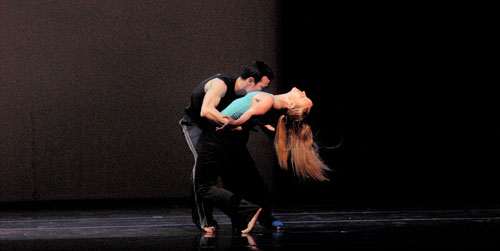
Kanji Segawa and Erika Pujic
Note: as of spring 2011 Robert Battle is to take over as Artistic Director of Alvin Ailey from the retiring Judith Jamison.
http://www.battleworksdance.com
Saturday 25 October 2008
This concert is part of an effort working with UMKC conservatory and Wylliams/Henry to put pieces on both
the dance department and on Wylliams/Henry as well as a master class for the students,
taught daily for a week by Robert Battle.
 Kanji Segawa and Erika Pujic |
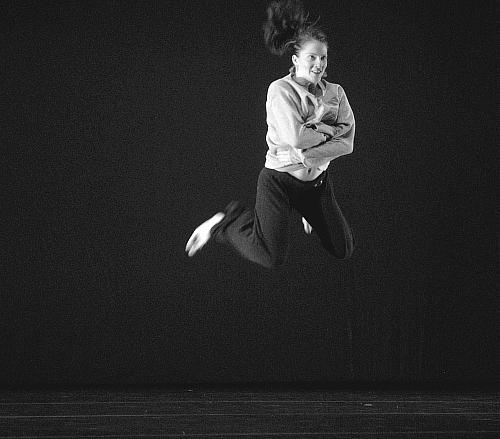
Marlena Wolfe in "Ella" - scatting physically to Ella Fitzgerald
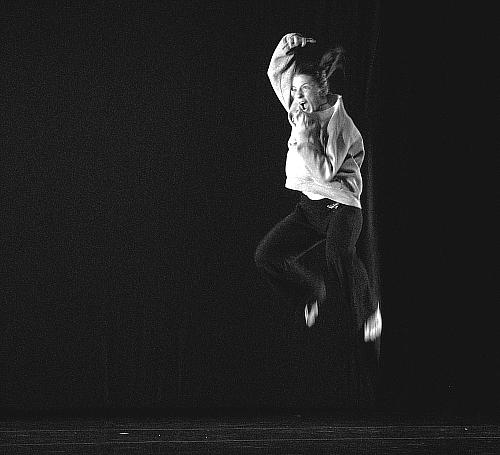
Martial Arts + Modern Dance = Robert Battle
by Mike Strong
I've seen Robert Battle's choreography described as high-energy, frenetic but there are other groups with high and frenetic energy. The difference is in the un-prepped blindingly fast instant moves, the moves which seem to come out of nowhere. Anyone who has ever taken even a medium amount of martial arts will recognize these movements. You start in one location and in a sudden spasm you've moved to another location in space.
That doesn't mean everything is fast. Robert's work ranges from high energy rapid to melodic and slow to outright slow motion. But because most of us are so used to a set of ideas about dance movement, both slow and smooth moves and high energy moves, the rapid jump-cut moves do the most to wake us out of our normal viewing mode.
Tyler Gilstrap, Samuel Roberts, Marlena Wolfe and Shanti Guirao in "Overture"Before I go further, and before I forget, I should note, as a small item, that there did not seem to be a large range in the pieces and the techniques. Part, I think is because of the extremely fast pacing in some of the movements, leaving little area for subtle colorations. That means the variations need to be expressed either in the aggregate of many fast motions or in the aggregated assemblage of dancers. This leave the danger that more attention is given to the technique than to the narrative. I would expand on that but I think the concept of high-frequency = less texture is a simple formula. Some of the variation went into a deliberate slo-mo action but that, from the other side of the movement scale, means more technique just to hold it and again, less texture. So, that is about as "negative" as I will
Dancer Terrence Poplar is from Kansas City and graduated from Paseo Academy of the Fine and Performing Arts. His training went through Ailey Camp to Smith Sisters school on Prospect, Westport Ballet, Kansas City Ballet, The Center Dance Joffrey and Ailey.Dance audiences are used to seeing dancers bunch up their muscles in preparation for a move, the prep. We don't normally take note of the "prep" perhaps because we are so used to it. Battleworks changes that and the result is startling. In martial arts the seemingly no-prep move is used to strike an opponent without "telegraphing" the strike. In dance Robert Battle's dancers seem to erupt from one location to another. From the floor into the air. From left side to right. Front to back.

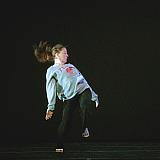
It is as though we are seeing a jump cut in a movie where frames of the movie are cut out. But here there is no editing, no cutting out of frames, just very fast action in front of your eyes. (Think Bruce Lee, faster than 24-frames-per-second, I will get to Lee later along with video-equipment upgrade musings.) In combination with the no-visible-prep, there is also the last-instant accelerated ending to a movement, which is straight out of martial arts.
The last little section of a quick Battleworks move snaps into its position. A move which starts fast enough, then really snaps in at the end of the move. In martial arts this snap at the end of the move fully imparts the final, hard force to a blow. In a sense the start of the move is a prep/plus/acceleration which gets you to the final snap, at contact. The complete strike.
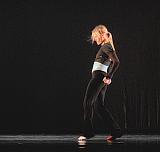

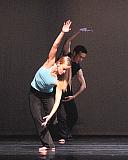


BattleWorks Challenges Our Concepts of Dance
by Nicole English
BattleWorks Dance Company hit the stage like gangbusters on Saturday, October 25 in White Recital Hall of the Conservatory Performing Arts Center. Patrons looking for something very different in dance were not disappointed.
"This has been a very different experience for me... the dance I am used to seeing was always moving, and flowing, and this was all very different," said Sharell Wheeler, a business major at Bloch School. "The movements were different, the style was different.... but it was very entertaining."
The choreography of Robert Battle tends to be very counter-intuitive to more traditional forms of dance. Battle's style could almost be its own genre of dance..
Although he grew up in a household that supported the theatrical arts, Battle studied martial arts for several years in his teens before he became a full-time dancer in high school. The influence of the martial arts in his work is very apparent. He utilizes a variety of jumps, circle kicks, spins, flips, and full-body falls that could come directly from the martial arts. But his choreography also seems to reflect the practice of martial arts in a much more profound way, such as keeping your opponent off-guard, doing the unexpected, deliberately alter your timing, and most importantly, not telegraphing your intended movements.
Although the choreography seems frenzied at times, full of stops and starts, it is fascinating to watch and holds your attention, simply because it is difficult to predict, and thus, is full of surprises. There is a great deal of movement packed into a small amount of time and space, keeping the viewer continually off-balance.
"It really kept my attention... I could not take my eyes off of the dancing... even to check the program," said Billie Mahoney, well-known dance teacher and performer. "The dances are brutal... because the movements seem to spring from nowhere... with no preparation... jumping into superlative heights."
As dramatic as the choreography is, it is sometimes difficult to watch for the same reasons it is so compelling. The movements are executed in a manner so fast and furious, that the splendid technique of the dancers and the complicated choreography can be lost in a frenzy of movement. It is a lot of perceptual information to absorb and appreciate all concentrated into a short experiential moment. Because the movements are unpredictable, it keeps the viewer on edge for the entire performance, which holds the attention, but can be draining in large doses. Finally, the incredible stamina of the dancers is almost beyond belief, but exhausting to watch.
That said, Robert Battle's complicated choreography is fresh, contemporary, exciting, and edgy. Although one can point to various influences to his choreography, such as Alvin Ailey, Paul Taylor, Jose Limon, etc., his final product is entirely in his own, and told in his own artistic voice. He often looks back to the founders of modern dance, (such as Ted Shawn, Ruth St. Denis, and Martha Graham), for inspiration and courage to be innovative.
"When I look back at these courageous people in past, [making a radical break with traditional dance], stepping out like that, it is inspirational," says Robert Battle about the choreographers whom he admires. "It makes me feel that I am somehow a part of that legacy of dance... that I am not alone... and it gives me the courage to be criticized and continue on... for each of us has to tell our own truth."
The show opened with a new composition, Reel Time, that was commissioned by the American Dance Festival as part of their 75th Anniversary Season. An ensemble number set to the experimental music of John King, its frenzied pace set the tone for the entire concert. The piece also featured rehearsal director, Erika Pujic, and established her as a remarkable dancer and difficult to miss with her unbelievable stamina and flurry of long blonde hair.
"Erika is fantastic," said Jered Solace, a professional dancer and founder of the Solace Collective. "She has it all together... grace, strength, emoting on stage... and definitely stamina."
The second number, Ella, was solo performed by Marlena Wolfe to the music of Ella Fitzgerald. Her physical movements closely matched and articulated the verbal scat of the song, creating a new dimension for seeing dance.
The third piece was Overture, set to music by Johann Sebastian Bach, which was another ensemble work that came the closest to what we think of as a traditional modern dance suite. It used unusual combinations of movements, both slow and staccato, smooth and vibratory, in contrast to each other, suggestive of dancers engaging in a conversation of movement.
"This piece was probably my favorite," said Jered Solace of the Solace Collective. "I liked the contrast of the fast and slow... of combining creative timing and movement."
After intermission, the show opened with another new work, In / Side, which was commissioned by Dance New Amsterdam as a part of the Company of Men. This dark, brooding male solo stood out for its sensual masculine movement and range of emotional content, deftly executed by Samuel L. Roberts to the music of Nina Simone.
"My favorite part was the male solo," said Tyrone Aiken, artistic coordinator for the Kansas City Friends of Alvin Ailey program. "You can see when someone understands choreographer's style and understands choreographer's intent... that came through in the movements.. which were rich, full, sensual, and lush... displaying many emotions about longing, wanting, striving... and I also think that the music was incredibly beautiful.... it was really an incredibly wonderful piece."
The closing number was Juba, a work and score that were originally commissioned by the Alvin Ailey American Dance Theatre, and performed to music composed by John Mackey. This dramatic, energetic piece entailed much locomotion and running movements in a variety of floor patterns that were suggestive of folkloric dance at times.
"I loved Robert Battle's composition of this piece, said James Jordan. "His use of patterns, the circle in and out... the connection with the music."
Even more telling, thought Jordan, was the energy of the choreography, and what it said of the choreographer and dancers.
"The investment of energy was tremendous," added Jordan. "it was just a powerhouse.... I cannot imagine how they sustain that on a tour... where they have to pull out that energy every time they perform.... but they clearly do that ... so Robert Battle must be able to inspire the dancers to reach that level of energy... and to me, that is a sign of a good director.... to be able to pull that kind of power from his dancers."
The performance was innovative and a definite change of pace for the Kansas City dance community. But it seemed to be change of fare the community was willing to embrace, and may wish to indulge again at a future date.
"This was our debut in Kansas City," said Robert Battle, the founder, choreographer, and artistic director for the company. "But it has been a nice experience, and we hope to come back."
 Email This Page
Email This Page
Dance Division moments between studio classes
Fall Concerts
With staff and guest choreography
November 2017
November 2016
November 2015
November 2013
November 2012
November 2011
November 2010
November 2009
November 2008
November 2007
November 2006
November 2005
Spring Concerts
Held every April with staff and visiting choreography. A showcase for the year.
April 2017
April 2016
April 2014
April 2012
April 2011
April 2010
April 2008
April 2007
Other Dance Concerts and Dance Division Events at UMKC
Held every April with staff and visiting choreography. A showcase for the year.
Carmina Burana
CORPS de Ballet 2011 Conference with the introduction of the Tudor Curriculum
Battleworks Concert - 25 October 2008
UMKC Master Class with Robert Battle - 20-24 Oct 2008
Note: as of spring 2011 Robert Battle took over as Artistic Director of Alvin Ailey from the retiring Judith Jamison.
Master Class with Donald McKayle - August 2006
100th Year Anniversaryof the Conservatory - April 2006
Senior Recitals
These are held in the winter semester and the graduating seniors begin signups and rehearsals early in the fall semester. This is one of their last graded works. Each senior choreographs and directs a group piece and performs in a solo which may be self-choreography or another's and may also be a duet if there is a large enough mix of solo to duet.
There are a number of recital concerts, depending on the total number of seniors. Generally the mid-week concerts have in-town seniors while those with families out of town are scheduled for Saturdays so relatives can attend.
Senior Recital 2012
Senior Recital 2011
Senior Recital 2008
Senior Recital 2007
Senior Recital 2005
Related Links
Non-UMKC events which have UMKC dancers, staff or visiting artists.
Don McKayle talk 24 Jan 2008 at Public Library, KCMO about Kansas City Ballet piece he was commisioned to create.
UMKC guys in Romeo and Juliet at Kansas City Ballet Spring 2008 backstage in costumes.
Wylliams/Henry Sept 2006 and "Games ," choreography Donald McKayle.
For some of the least expensive, good dance entertainment in Kansas City the University of Missouri Kansas City's Conservatory of Dance and Music's Dance Division offers some of the best young adult dancers in the area. UMKC's Dance Division is among the top dance schools in the country. Those of us who live in this area often miss that distinction but people elsewhere know (isn't it always so?).